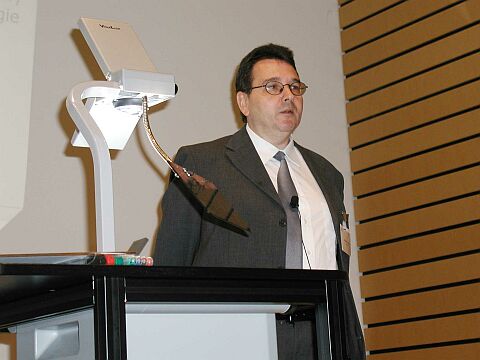«Nano: is the future quite as bright as it seems?»
Seeing the risks as well as the potential
«Nano: is the future quite as bright as it seems?» This was the title of a discussion held at the EMPA Academy by 40 persons from the science, economic and media worlds. Initiated and organized by the Risiko-Dialog Foundation, St. Gallen, it covered the topic «perspectives and risks in nanotechnology».

|
«I have become skeptical» said one representative of
a Swiss daily newspaper at the end of the event, held on 18th June.
And «I am beginning to wonder if there isn’t some truth
in all these warnings about nanotechnology». These were
exactly the sort of questions which the Risiko-Dialog Foundation,
St. Gallen, wanted to encourage at this event, which it calls a
«Learning expedition», held at the EMPA Academy in
Dubendorf. |
||||
|
Nanotechnology from the scientific and ethical point of view An idea of what pushing the frontiers of research down into atomic dimensions might mean to the future man in the street was provided by EMPA Director Prof. Louis Schlapbach. One example he gave was of superflat displays in which millions of tiny carbon tubes of nanometer dimensions create the picture. The first contacts with industry have already been made regarding this application. Caution still needed to be exercised in the practical aspects of handling and using such nanoparticles, since it is not yet known, for example, what effect they might have when inhaled by workers. |
|||
|
Relevant social scenarios were described by the philosopher and ethicist Dr. Klaus Peter Rippe. Nanotechnology, as the «key technology of the 21st century», will certainly have an effect on society. According to Rippe, ethicists are interested in three decisive aspects of any new technology – respect, fairness and sustainability. With regard to respect, he called for a monitored approach with adequate protection for personal data. For example, he asked if patients are told when nanotechnology techniques are used in the development of new medication. By fairness, he meant that access to these new technologies must also be open to developing nations. As regards sustainability, one needed to ask if there was a possibility that the new technology might release toxins into the surroundings, and if it were generally environmentally friendly. |
||||
|
Nano-Dialog between hype, hope and hysteria The public discussion about the potential benefits and risks of nanotechnology is still at an early stage, yet despite this a certain similarity to the gene technology debate can be seen, according Christoph Meili of the Risiko-Dialog Foundation. He felt that there was already a great opportunity for risk dialog – the exchange of ideas between various interest groups – to begin right away. This process, however, must involve interactive communication and not just a passive exchange of information. At the moment the first signs of such a process are beginning to appear. One of these early signs was the discussion meeting at the EMPA Academy, where the participants experienced nanotechnology at first hand during the laboratory visits and held intense discussions on it during the workshops. The meeting heightened awareness of the subject, as the comment of one researcher shows: «In future I will consider the risks more carefully when I begin work on a new research project. Perhaps an independent body should perform this sort of risk assessment.» |
||||
|
Contact person: Dr Christoph Meili Editorial: |
||||
|
||||

